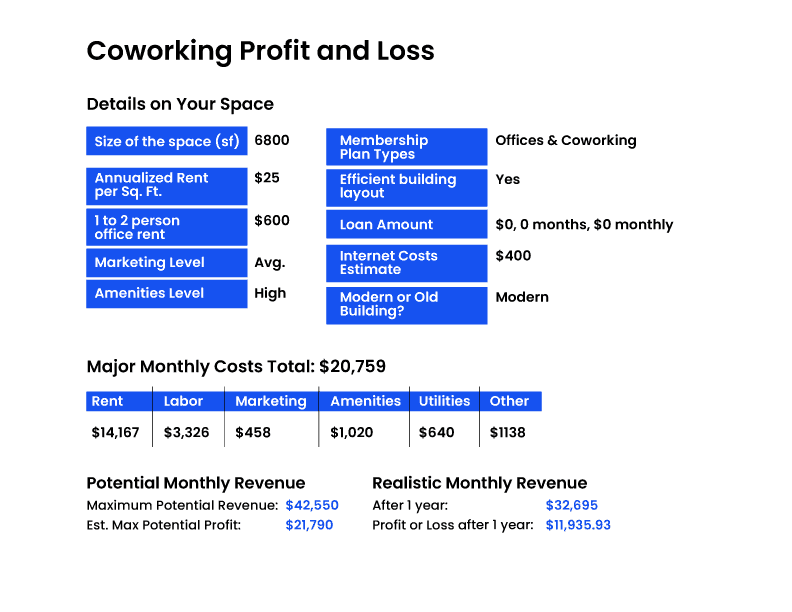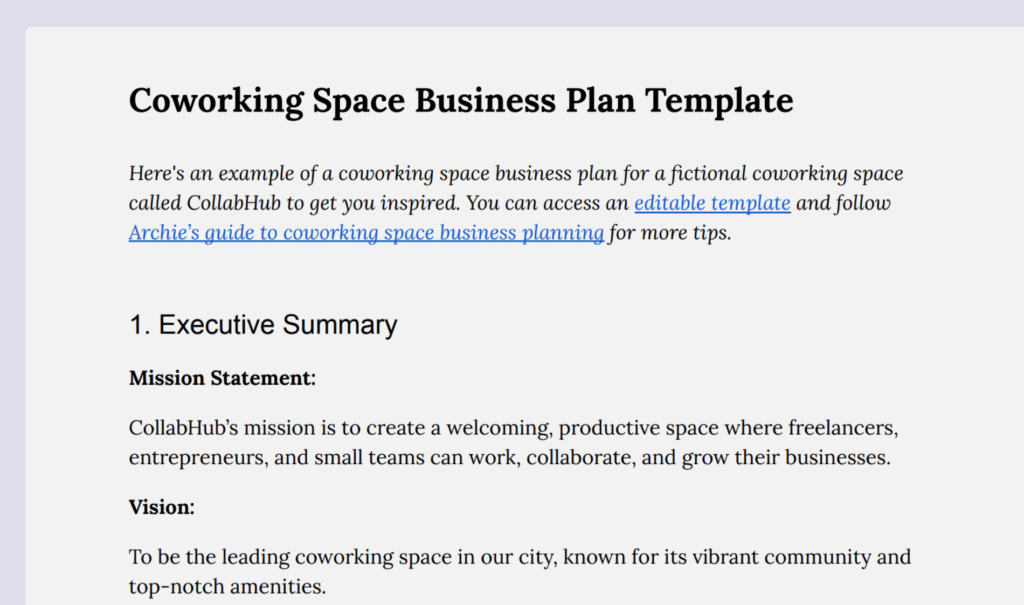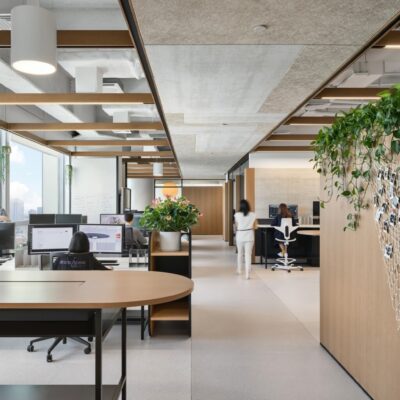- Originally published: May 5, 2022
- Last updated: January 22, 2025
So, you’ve got an idea for a coworking business. Maybe it’s just a vague thought, or perhaps you’ve written down a few notes. Now, to turn that idea into reality, you’ll need a solid coworking space business plan.
A solid coworking space business model isn’t just for impressing potential investors (though it will definitely help with that). It’s also your roadmap for building and running your coworking business.
Guide to coworking business plans
What is a coworking space business plan?
A coworking space business plan is a written document that outlines your vision for starting and running a coworking space. It acts as a roadmap, explaining your goals, strategies, and how your business will operate and make money.
Why (and when) do you need a coworking business plan?
Creating a coworking business plan is one of the most important steps in starting or growing a business. It’s crucial if you need investors or financial support, as it shows that you’ve carefully considered your idea and have a clear plan for success.
But, a coworking space business plan isn’t just for getting started; it’s also a valuable tool for growing an existing coworking space. It helps you stay focused on your original goals while adapting to changes in the market. For example, it can outline how many members you’ll need to break even, what services you’ll offer, and how to handle potential challenges. A coworking space business plan keeps you organized and on track by breaking everything down into smaller, actionable steps.
Plus, researching for your business plan helps you learn about your competition, understand your target audience, and stay informed about trends in the coworking industry. This knowledge is key to creating a space that stands out and meets your members’ needs.
While writing a business plan might seem overwhelming at first, it’s worth the effort. It covers a lot of ground, from your goals and strategies to financial projections. To make it easier, this guide will walk you through the essential parts of a coworking business plan and even provide templates to help you get started.

How to write a coworking space business plan
Creating a solid plan for your coworking space is the first step to running a successful and profitable business. It’s all about understanding who you’re serving, designing a space they’ll love, and figuring out how to make money while keeping things running smoothly. Here’s how to get started:
1. Start with thorough research
Your coworking space business strategy should be grounded in market and competitor research. Before deciding on location or offerings, you need to understand your target audience, market size, growth trends, and competition.
Ask yourself these questions:
- How big is the market, and how fast is it growing?
- What are the latest trends in coworking?
- Who is your target demographic?
- Who are your competitors, and what sets them apart?
Understanding your competitors’ member numbers, revenue, messaging, and positioning can help you identify gaps and opportunities.
2. Picture your space and who it’s for
Think about the kind of coworking space you want to create. Will it be a high-end spot for big companies or a cozy, affordable place for freelancers? Is it focused on networking and events, or does it provide a quiet, productive atmosphere? Answering these questions will guide decisions about pricing, amenities, and marketing.
Next, get to know your audience. Are you catering to freelancers, remote workers, or startups? Will your space offer shared desks, private offices, or both? Tailor your services to what they need and make sure your space reflects what they value most.
3. Plan how you’ll earn money
Figuring out how your coworking space will earn money is a key step in setting it up for success. Your business model is the plan for how you’ll earn income and keep things running smoothly.
Most coworking spaces make their money by renting out workspaces, such as:
- Hot desks: Shared desks that members can use as needed.
- Dedicated desks: Personal desks reserved for regular members.
- Meeting rooms: Spaces for meetings, presentations, or workshops.
- Private offices: Exclusive spaces for individuals or small teams.
Membership fees will likely be your primary source of income, so offer flexible plans to suit different needs. For example, you can have short-term options like hot desks, regular memberships for dedicated desks, or team memberships for companies.
When I first opened my coworking space, I focused on long-term members and office sales. After a few months, I realized that this traditional focus was limiting the number of people I could convert, and I was missing out on a large market segment that was active in my region. Not wanting to miss out on potential revenue, I decided to diversify my service offerings and target a broader audience. I saw the untapped potential of non-members and the rising demand for flexible options for room bookings and day pass users. I developed a public online signup and booking page, making it effortless for anyone to discover and access the coworking space. I also integrated self-serve automations for both bookings and day passes to cut down on the work that would be required to onboard and serve these bookings. The ease of online bookings attracted new users, significantly driving up utilization rates and diversifying revenue streams.
To bring in more money, think about adding extras like selling coffee, hosting events, or renting meeting rooms during off-hours. You don’t need to plan every detail right away, but having a clear idea of how you’ll use your space and what services you’ll offer will help you move forward.
You can earn extra income by offering:
- Workshops and events: Paid classes, networking events, or training sessions.
- Virtual office services: Let businesses use your address for mail and offer call handling.
- Special amenities: Fitness areas, childcare, or quiet rooms.
- Event rentals: Rent your space for private parties or gatherings.
- Equipment rentals: Offer items like podcasting tools or tech gear.
- Food and drinks: Sell coffee and snacks, or even set up a small café.
💡 To sum up, a strong coworking space business model includes a mix of key elements. Membership plans are at the core, offering flexible options such as hot desks, private offices, or team packages, with pricing tailored to the level of access and coworking space amenities provided. Additional revenue can come from event space rentals, where meeting rooms or other areas are used for workshops and private gatherings. Extra services, like printing, mail handling, or snack sales, provide further income streams while improving the member experience.
By focusing on these key components, you can build a coworking space business model that not only generates revenue but also creates a space that meets the needs of your members and encourages long-term success.
4. Tailor your business plan to the audience
When writing your coworking space business plan, always consider who will read it and what matters most to them. It’s easy to feel overwhelmed when trying to include so much information, but focusing on your audience’s priorities will help you stay clear and concise.
Put yourself in their shoes:
- Who are they? Are they investors, lenders, or partners?
- What do they care about? Are they looking for financial returns, market opportunities, or a solid growth plan?
- What do they need to know? Are they seeking evidence of market demand, clear differentiation from competitors, or detailed revenue models?
Tailor your business plan to address these questions. Highlight the key drivers of business success, such as:
- Market research: Show there’s room for your coworking space to thrive.
- Competitor analysis: Explain how you’ll stand out in a competitive market.
- Products and services: Outline your revenue model and what you’ll offer.
- Financial model: Demonstrate that your space can grow and remain a profitable coworking business over time.
Before submitting your plan, read it through from your audience’s perspective. Ensure it is focused, easy to understand, and answers the questions they are most likely to have.
5. Use a coworking space business plan template
A coworking space business plan template saves you time and helps you include everything investors or partners need:
Key components of a coworking space business plan
A strong coworking space business plan includes key elements like your vision, market analysis, financial projections, and operational strategies. Here’s an overview of what to include and how to get started:
1. Executive summary
Think of this section as the elevator pitch for your coworking space business. It should provide a concise overview of your coworking space, including your mission, vision, and goals. Keep it short and engaging, as it sets the tone for the rest of the plan. It’s often easier to write this part last after you’ve worked through the details of your plan. If you need extra guidance, reviewing business plan examples can help you see how to structure it effectively.
2. Company description
The company description is a key part of your coworking business plan — it lays the groundwork for your entire project. In this section, you need to clearly explain who you are and what your coworking space will do.
Define your business’s legal structure. Will it be a sole proprietorship, partnership, LLC, or corporation? Each structure has specific rules for liability, taxes, and funding, so choose carefully to suit your goals.
Then, use this section to highlight what makes your coworking space — and its location — unique. Explain how your business model addresses gaps or challenges in the market. Focus on your strengths and advantages to show why your space is a good investment.
This section of your coworking space business plan should inspire confidence in potential investors by showing that your coworking space is well-thought-out and has a solid plan for success.
3. Market analysis
Your coworking business plan needs to include thorough market research (followed by a detailed competitive analysis). This section provides an overview of your industry and potential opportunities, helping you understand where your coworking space fits and how to succeed.
Start by collecting data on industry trends, growth patterns, and your target audience. Your research should define the size of your market and its total potential. Establish a specific perimeter for your analysis — like a 10-mile radius around your location — and evaluate the competition. For example, look at other coworking spaces nearby to understand how they operate and attract members.
Good market research should answer these key questions:
- How will your coworking space influence customer behavior?
- Why is your chosen target market a good fit?
- How will your space meet your customers’ needs?
- What changes are expected in the market, and how will you adapt?
4. Competitive analysis
One of the first questions people will ask about your coworking space is: “What makes you different from the competition?” It’s essential to answer this confidently. While coworking spaces are not a new concept — they’ve been around for over 20 years and are found worldwide — standing out in the market is more critical than ever.
Your coworking space needs a clear niche or unique value proposition to succeed. Modern coworking thrives on offering specialized experiences tailored to specific groups. For instance, you might create a space designed for women, a luxury space with premium amenities, or a space geared toward tech startups.
The first step to differentiation is understanding your competition. Study both direct competitors (other coworking spaces) and indirect ones (like coffee shops or home offices). Identify what they offer and where they fall short. Then, use this information to articulate how your coworking space will provide something unique and valuable that others don’t.

5. Services and products
This section of your business plan should clearly explain the products or services your coworking space will offer and how they benefit your members. Consider it a detailed breakdown of what you’re selling and why it’s valuable.
Start by describing the services you’ll provide — hot desks, private offices, meeting rooms, or additional amenities like mail handling or printing services. This is also the place to highlight the unique offerings that set you apart from competitors, such as niche features or exclusive memberships.
Next, describe your membership options in detail. Will you offer flexible day passes, monthly memberships, or dedicated desks? Be specific about pricing and what each package includes. Your goal is to show potential members and investors exactly what they can expect and how your services cater to different needs.
Depending on your coworking space business model, this section can be concise or more in-depth. Either way, it’s a critical part of your plan because it connects your offerings to your business’s financial aspects. The pricing breakdown provided here will directly feed into the financial projections section of your plan, helping to demonstrate the potential revenue your coworking space can generate.
6. Marketing and sales plan
Now that you’ve outlined what your business offers, it’s time to focus on how you’ll grow it. This involves explaining your strategy for attracting and keeping customers through effective sales and marketing efforts.
Start by defining your ideal customer. Create a detailed “customer persona” including their age, occupation, hobbies, education, and interests. Understanding your audience will guide your coworking marketing efforts and ensure your strategy aligns with their preferences.
Next, outline your marketing plan. Will you focus on paid digital advertising, social media campaigns, or organic word-of-mouth growth? For instance, if your target audience isn’t active on Facebook, investing in Facebook ads may not be a smart move. Tailor your strategy to the channels where your audience is most active. Also, include your sales and marketing budget, as potential investors will want to see how much you plan to spend to grow your customer base.
Your marketing plan should address how you’ll attract customers and why they should choose your coworking space. Highlight your value proposition — what makes your business unique and valuable to your customers. This could be anything from an inspiring workspace design to services catering to specific needs, like child-friendly spaces or startup networking opportunities.
In addition, explain the practical aspects of your sales strategy. How will you reach your audience, promote your offerings, and close deals? Will you focus on online bookings, in-person tours, or partnerships with local businesses? Discuss pricing strategies, such as how much your services cost and why you’ve set those prices. You might also touch on the customer acquisition cost (how much it costs to get a new customer) and the lifetime value of a customer (how much revenue they’ll bring in over time).
7. Operations and management
The daily operations of a coworking space are similar in many ways to running a hotel. It’s all about keeping things running smoothly, day in and day out. Your operational plan should cover the essential tasks needed to maintain your space, such as:
- Staffing: How many employees will you need, and what will their roles be?
- Management: Who will oversee daily operations and ensure everything runs efficiently?
- Training: How will you prepare your team to handle member needs and deliver excellent service?
- Cleaning and Maintenance: What’s your plan for keeping the coworking space clean, safe, and in good condition?
- Reception Services: How will you welcome members and guests, manage bookings, and handle inquiries?
- Technology: Which coworking management software is needed? What about additional tools for an integrated coworking tech stack?
In this section, you can also mention your management team — outline your leaders and what they bring to the table. Highlight their experience, education, and skills to show why they’re the right fit for the job. This helps build confidence with potential investors or partners.
8. Financial projections
The financial section is the cornerstone of your coworking space business plan. After presenting your idea and strategy, it’s time to dive into the numbers. This is where you prove to investors that your coworking space has the potential to be a profitable and sustainable business.
Investors love data — it shows them that you’ve thought through the financial side of your venture. Your financial projections should demonstrate how and when your coworking space will become profitable. These are the key financial reports to include:
- Balance sheets show your business’s current financial health, outlining its assets, liabilities, and equity.
- Profit and Loss (P&L) statement summarizes your revenue, costs, and expenses, giving a snapshot of your business’s profitability over time.
- Operating budget breaks down your operational costs, such as rent, salaries, utilities, and maintenance.
- Break-even analysis forecasts when your coworking space will cover its costs and start making a profit.
If creating these financial documents feels overwhelming, don’t worry. You can hire a freelance accountant or a coworking expert to assist you. Alternatively, a coworking space financial model template can guide you in building accurate and compelling financial plans.

Your business plan should be clear and easy to follow. Too much detail can confuse readers, so focus on the most important points. Highlight what makes your coworking space unique to help it stand out. Structure your plan using free templates and tools to save time and stay organized.
Coworking business plan FAQ
A coworking space earns money by offering flexible workspaces to individuals, teams, and businesses. Most of the income comes from membership plans, which include options like shared desks (hot desks), reserved desks (dedicated desks), private offices, and team packages. Many spaces also make extra money by renting out meeting rooms, event spaces or selling day passes for short-term users.
In addition to memberships, coworking spaces can boost their income by offering services like printing, mail handling, or virtual office options. Some sell coffee and snacks, host workshops or classes, or rent out equipment like podcasting tools. Partnering with local businesses, like gyms or cafés, for discounts or sponsorships is another great way to add value for members and bring in more revenue.
Starting a coworking space business begins with good planning. First, research your market to determine your target audience and what they need. Decide what will make your coworking space special — maybe it’s designed for freelancers, startups, or a specific community. Create a business plan that explains your goals, pricing, layout, and how you’ll attract members. Include your budget and financial plans to ensure the business can grow.
Next, find a location that’s accessible and close to useful amenities. Design your space to be functional and comfortable, with a mix of desks, private offices, and meeting rooms. Once you’re ready to open, promote your coworking space with social media, local events, or special offers. Offer flexible membership plans to suit different needs and budgets. Focus on building a welcoming community where people feel valued, as this will help you keep members and grow your business over time.
Coworking spaces can be profitable, but their success depends on size, location, and good management. Most spaces take about 12-24 months to start making a profit, with nearly half becoming profitable within a year. Small spaces with up to 50 members usually just break even, while medium-sized spaces with 50-150 members often see profits of 10-20%. Larger spaces with 150 or more members can earn even more, with profit margins reaching 20-30% or higher.
























![The Latest Coworking Statistics & Industry Trends [2026] A cozy coworking space with wooden walls, warm lighting, and a large map of South America.](https://archieapp.co/blog/wp-content/uploads/2025/08/Latest-coworking-statistics-cover-image-400x400.jpg)

![How To Start a Coworking Space: Costs and Plan [2026 Guide] A modern coworking space with white desks, ergonomic chairs, and laptops.](https://archieapp.co/blog/wp-content/uploads/2023/11/Screen-Shot-2023-11-30-at-9.33.09-AM-400x400.png)
